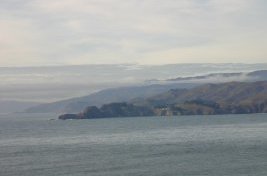
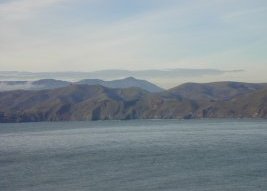
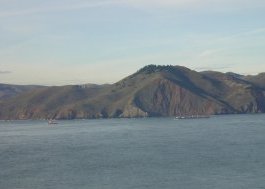
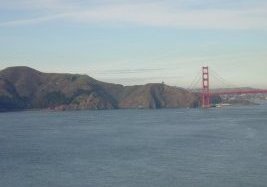
    |
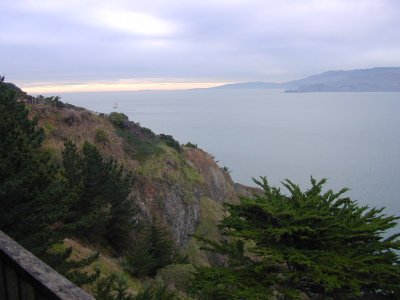 |
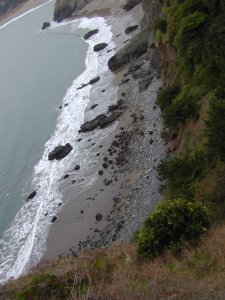 |
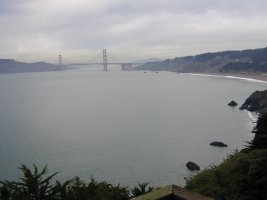 |
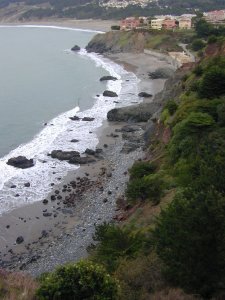 |
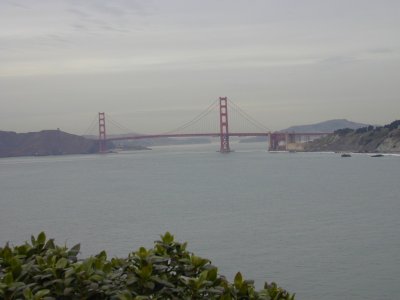 |
|
| GEOLOGY |
|
|
 |
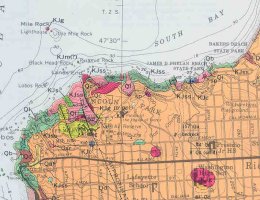 |
|
| Lincoln Park & Sea Cliff (USGS 1958) | Lincoln Park & Sea Cliff (USGS 1974) | |
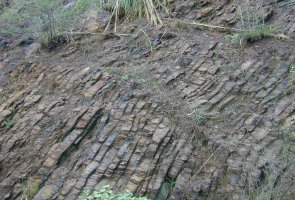 |
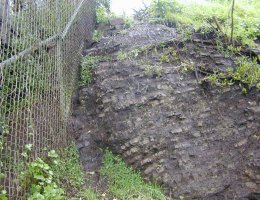 |
|
| Radiolarian Chert, typical N SF Quadrangle | Radiolarian Chert, exposed at site | |
| Geologic Setting: The site is underlain with sedimentary bedrock of reddish-brown Radiolarian Chert [KJc], (observed) a prominent indurated rock type of the Franciscan formation, and Graywacke Sandstone [KJss] (observed and mapped, Schlocker 1974), a clastic sedimentary rock also Franciscan. Graywacke is thickbedded "dirty" sandstone; a poorly sorted mixture of angular and subangular grains ranging from fine to very coarse sand in size. The Franciscan Formation is Jurrassic and Lower & Upper Cretaceous age (Mesozoic; 144 to 208 million years old). |
|
|
| Radiolarian Chert &
Graywacke Sandstone: Siliceous shale is generally interbedded with the chert (Bailey 1964). Radiolarian chert is exposed at Lincoln Park, immediately adjacent to the site (sandstone exposures also appear at some distance from the site). The chert is contorted (pinched and swelled); the ribbon layering of the chert beds has definite thin banded structures that are locally jointed and tightly folded with nearly horizontal axial folded planes. The chert is a very hard, compact, siliceous rock; the red pigmentation is caused by fine particles of ferric oxide; this sedimentary rock is believed to have been a colloidal gel formed by precipitation of silica (chalcedony and quartz enclosing skeletons and spicules of Radiolaria; Radiolaria appears in the red chert as tiny, colorless, spherical or bell-shaped masses) and small amounts of iron and aluminum oxides from sea water. Where exposed, the chert appears slight to moderately weathered. Slope stability in chert is generally good, however the bands of interbedded shale are susceptible to seepage and weathering. Over the chert, the slope is mantled with creep zones composed of colluvium. Colluvium is unconsolidated and unsorted soil material and weathered rock fragments accumulated on or at the base of the slope by natural gravitational or slope wash processes. |
| References
Bailey, Edgar H., Irwin, William P., & Jones, David L.,
1964; "Franciscan
and Related Rocks, and their Significance in the Schlocker, J., Bonilla, M. G., & Radbruch, D. H., 1958;
“Geology
of the San Francisco North Quadrangle, California”, Schlocker, Julius, 1974; "Geology of the San Francisco North
Quadrangle,
California", (includes Plates [1] "Geologic Map....", |
|
| 1964 Construction "Townhouse for Mr. & Mrs. Richard S. Bullis", designed by Kump Associates Architects, 1963. Photos during construction taken January, March, and April 1964. |
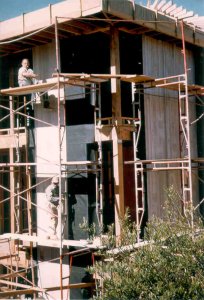 Northwest Corner (upper) |
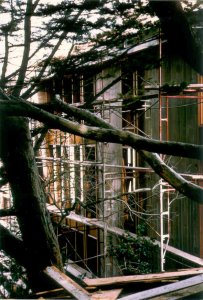 West Elevation (from street) |
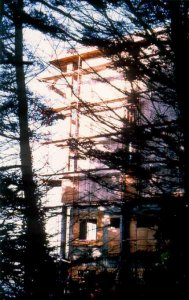 West Elevation (from park) |
 South Elevation (upper) |
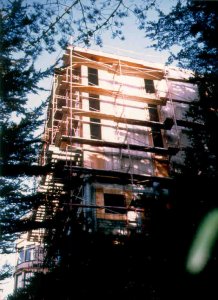 Partial South Elevation |
|
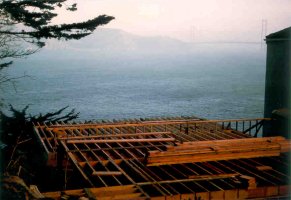 |
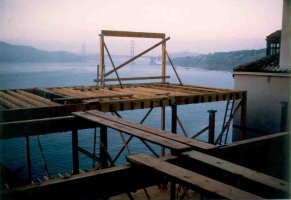 |
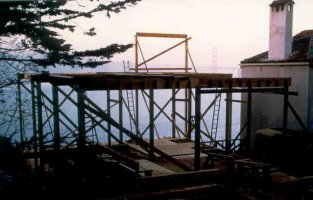 |
Left Image: Second (top) floor level before wall
framing Middle Image: Top floor framing, starting walls,
atrium
at right Right Image: North section framed first: |
|
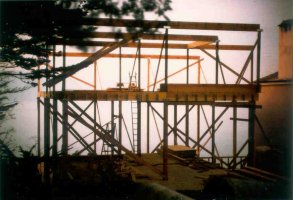 |
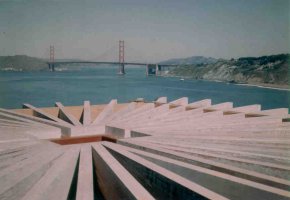 |
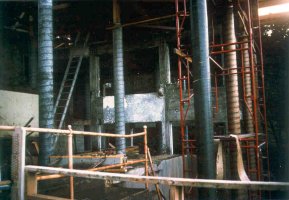 |
Left Image: Ballon framing, main and upper
floors, looking
north Middle Image: Right Image: |
|
|
|
| Slender Columns:
The concrete sonotube columns along the north side are cracked at their heads (below connection to upper two stories that are wood framed). Columns are too slender and upper connection is not "fixed" to resist lateral movement and joint rotation due to sidesway,and they are not recinforced as columns (insufficient reinforcement and confinement). New concrete foundation and new wood wall will stiffen columns but not to the extent that all seismic or wind forces will be transferred to upper stories (mostly glass) without dampening. Along with stiffening and confining of the columns, concrete cracks mayl be epoxy injected to protect reinforcement. |
|
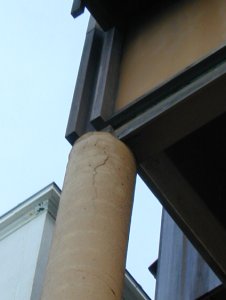 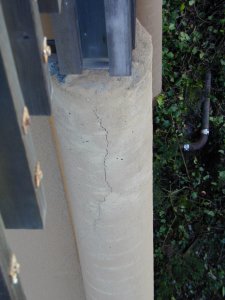 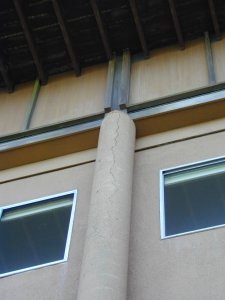 |
|
| Lower Tieback Wall: Three post-tensioned double corrosion protected Dywidag tiebacks will be installed through openings cut in the existing lower concrete foundations (underpinned in 1941 & 1983). Tiebacks will extend to anchororage in a new reinforced concrete cross-lot wall that stiffens the slender sonotube concrete columns, also being foundation for a new wood framed wall (office, lower bedrooms, game rm). Framed wall will also vertically/laterally support upper two stories. New foundation wall will integrate/interconnect 1921, 1927, 1963, 1941 & 1983 foundations and 1988 retaining wall. |
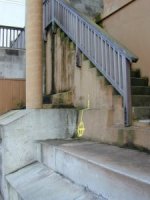 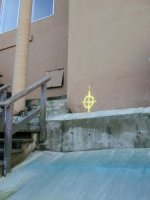 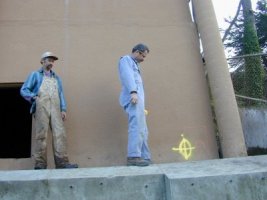 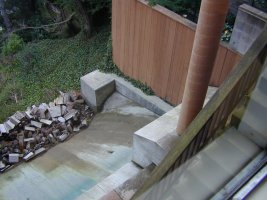 |
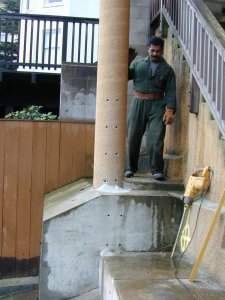 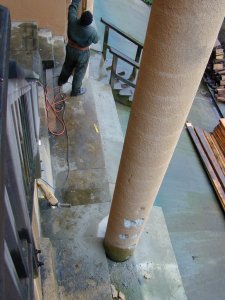 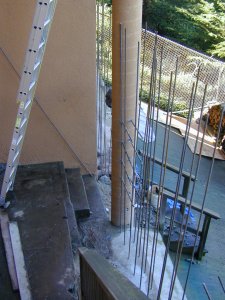 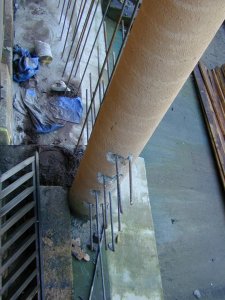 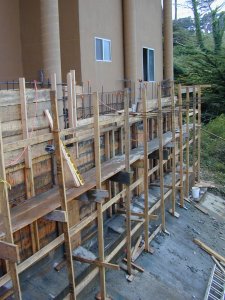  |
| Middle Tieback Wall: Preparing foundation (1927) for underpinning with new tieback wall (extends across back walls of wine cellar and office). Wall (1963) where concrete is cut (in office area) will be removed when intermedate wall is stabilized. Three postensioned double corrosion protected Dywidag tiebacks will be installed through holes cut in the existing intermediate concrete foundation wall, which is distressed at its western portion. The tiebacks will extend and later be anchored to a new reinforced concrete wall sistered to the existing cross-building wall/foundation at the rear or the office and wine cellar. New wall will integrate and interconnect the 1921, 1927 and 1963 foundations which are presently discontinuous. 2/3/00 |
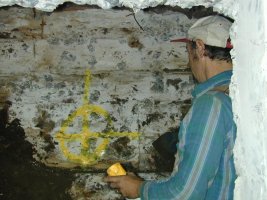 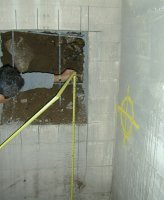 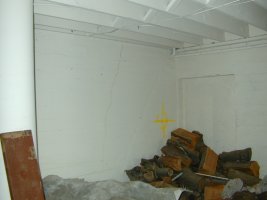 |
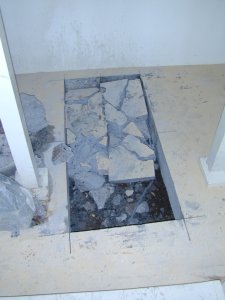 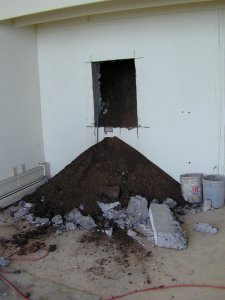 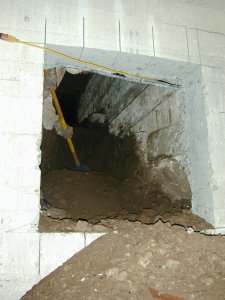 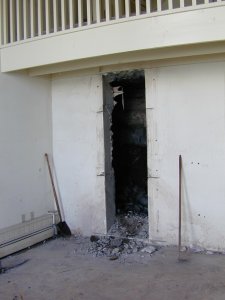 |
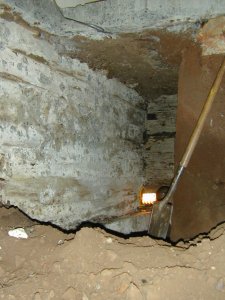 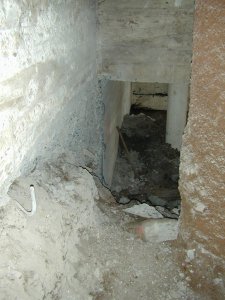 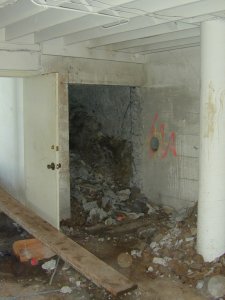 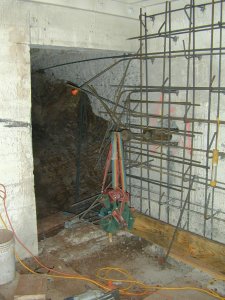 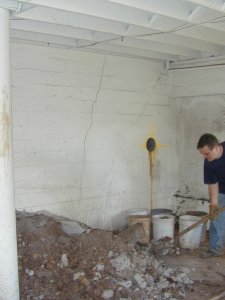 |
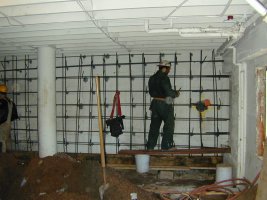 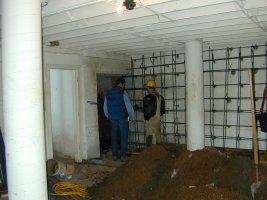 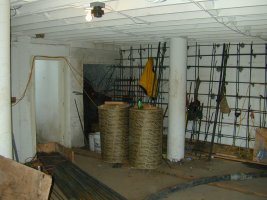 |
| Intermediate Tieback Wall: The western section of the building is broken up into three levels below the main floor level, and foundation support is compromised by landslide debris that underlys the western foundation. To provide vertical support (for building loads and the vertical component of tieback forces) intersections of transverse walls with the western wall will be underpinned (to depths of 19 and 22 feet). The underpinning, along with the 1927 and 1963 foundations, will be integrated and lateral support will be provided by two tiebacks. |
 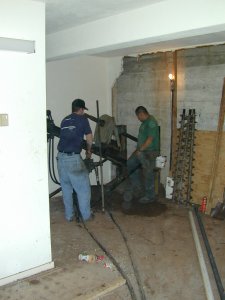 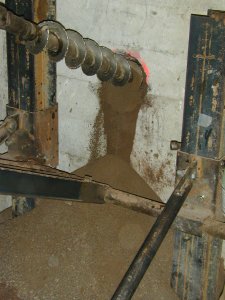 |
| Upper Tiebacks at Courtyard: Two postensioned double corrosion protected Dywidag tiebacks, anchored to reinforced concrete ring and bridge in courtyard that integrates garage and residence foundations, will push garage and pull residence foundations. All new reinforced concrete improvements will be interconnected with each other and they will be interconnected with 1921, 1927 and 1963 foundations which are presently discontinuous. In courtyard, tiebacks will be drilled under garages and grouted, and tested, prior to forming and pouring.grade beams that constitute the ring. After the tieback grout and grade beam concrete achieves strength, tiebacks will tensioned and anchored to the upper grade beam portion of the ring. 2/1/00 |
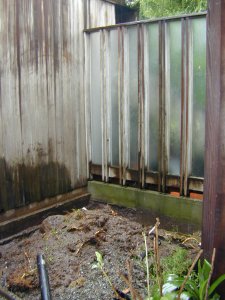 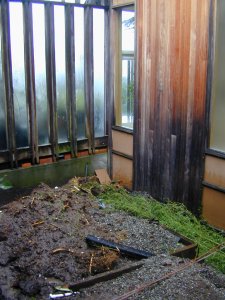 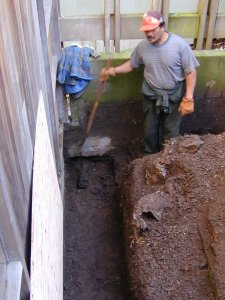 |
  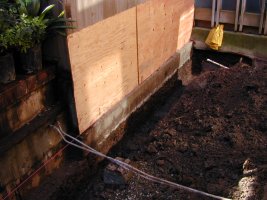 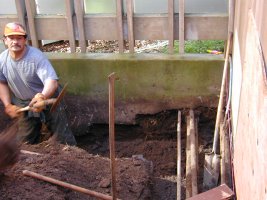 |
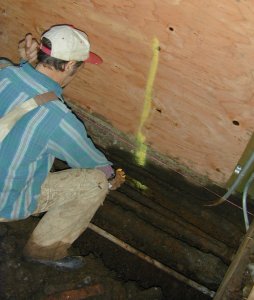 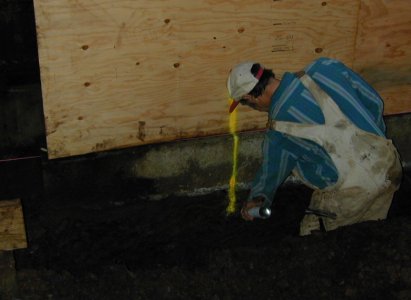 |
| Courtyard : Layout of stirrup reinforcing. Left is at east tieback, center is at west tieback, and right is at northwest corner (near Breakfast Room) where there is a 1963 pier (which will be chipped into to expose and tie new reinforcing. At tiebacks, shear forces, which induce diagonal tension stresses into the grade beams, must be resisted with closely spaced stirrups (terned "web reinforcing"). |
|
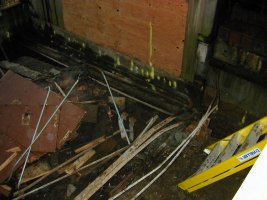 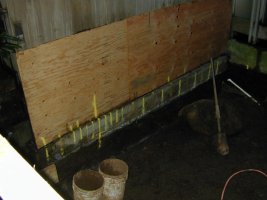 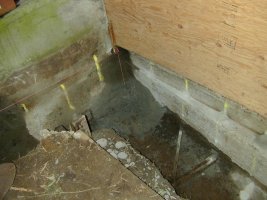 |
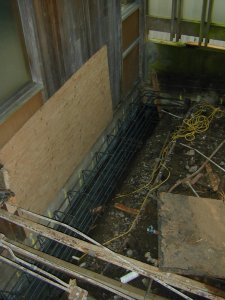 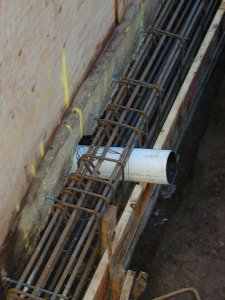 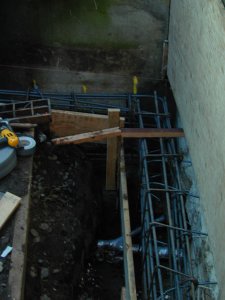 |